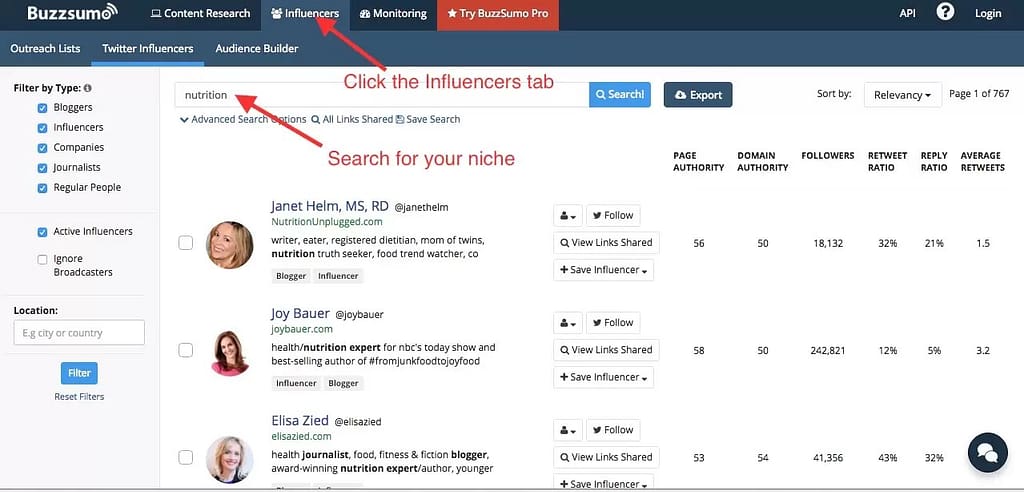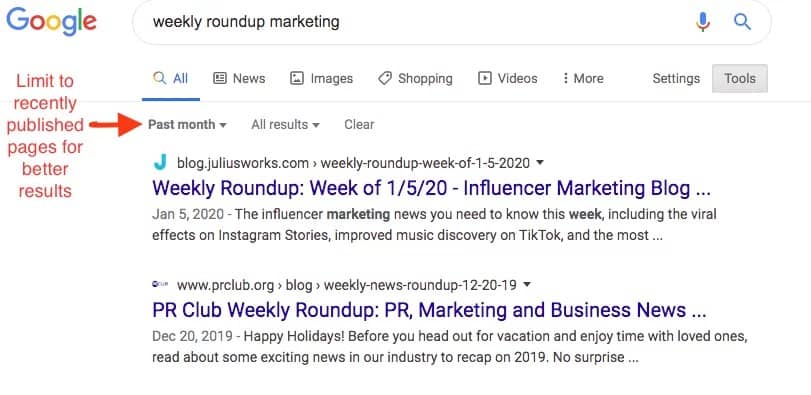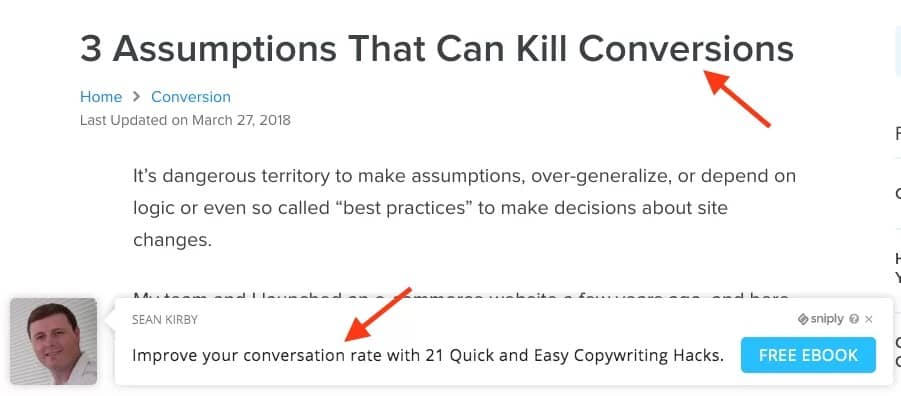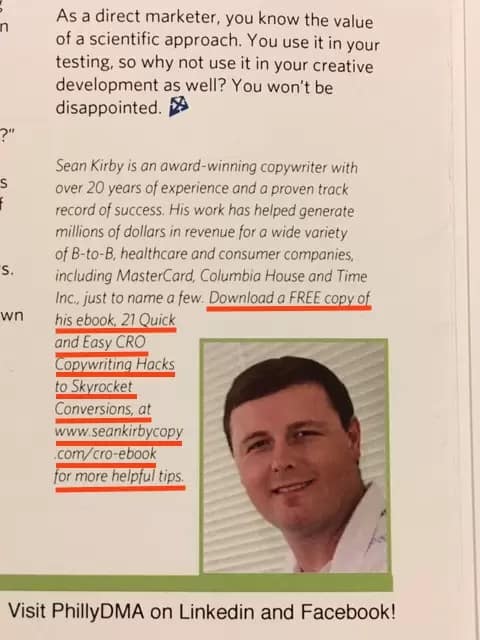If you’re like me, then creating content is the easy part. Promoting that content is the challenge. That’s why I created this big list of content promotion tactics.
But before diving in, if you haven’t already, read this post. That’s going to help you develop a plan for long-term success that will make all of these tactics more effective.
One other word of advice before moving on: This blog post is massive (over 5,000 words), and not every content promotion tactic covered is going to be worth the time and effort for every blog. Focus on the ones that provide the best results for you and don’t worry about the others.
To make it a little easier to navigate, I’ve included a table of contents.
Content Promotion Tactics
- SEO
- Email your content to subscribers
- Include a link in your email signature
- Post to your social media accounts
- Send direct messages in Twitter
- Include Click to Tweets in your posts
- Use snip.ly to turn curation into promotion
- Guest blogging
- Syndicate your content
- Submit your content to aggregator sites
- Share articles in online communities and forums
- Submit to social bookmarking sites
- Microblog with Tumblr
- Reach out to influencers
- Reach out to people who curate content
- Answer questions on Quora
- Leave comments on other blogs
- Promote on your own site
- Run Facebook ads
- Run Twitter ads
- Use content syndication networks
SEO
Search engines have the potential to deliver massive amounts of targeted traffic on an ongoing basis. Google alone processes over 40,000 search queries every second on average.
The problem is, most of that traffic never gets beyond the first few results on the page. That’s where SEO comes in.
Getting your content to rank high in search engines takes considerable time and effort, but it’s well worth it. Sites like Wordstream and WebMD, just to name a couple, get the majority of their traffic this way.
If you’re not familiar with search engine optimization, check out this beginner’s guide put together by the folks at MOZ. It’s an excellent resource for learning the basics that won’t overwhelm you.
It would be impossible to include everything there is to know about SEO in this post. (There are entire websites dedicated to these topics that continue to regularly publish new content.) But at the risk of oversimplifying, it all boils down to three things:
1. Creating content that meets the needs of your market based on their searches
Keyword stuffing is not a viable strategy in 2020. But it does no good to create content that nobody is searching for. That’s why keyword research remains an important part of SEO.
Finding good keywords can be a tricky balancing act. You’re looking for something that has enough search volume to generate worthwhile traffic, but isn’t so competitive that you’ll never be able to rank.
Here are a few tips that may help:
Search for long tail keywords. These are phrases that include multiple words like the example below.The search volume decreases with the length of the tail, but so does the competition. And because it’s specific, it’s easier to match the searcher’s intent. In the example below, that would be learning beginner SEO strategies.
Use a tool like Google Keyword Planner to find information on how many times per month that term is searched and how competitive it is. Use the suggestion feature to find the specific phrasing that gives you the best mix of volume vs. competition.
Plug your terms into Google Trends to see how much interest there is in that search over time. If you notice any that are trending up, you may want to prioritize those first to take advantage.
For in-depth keyword research instruction, I recommend Brain Dean’s Definitive Guide.
Once you know what people are searching for, it’s time to create content to meets those needs. At a minimum you want it to be:
- Unique in some way. There’s a lot of parroting on the Internet these days, and it feels like you read the same articles over again and again with just different wording. Add something new to the conversation.
- Easy to read and understand. If it feels like work, I’ll just go to the next option.
- Entertaining. I know a lot of people think of content as more educational. And to an extent it is, but the education has to be enjoyable or nobody will bother.
- Satisfying. Great content answers the questions readers have and gives them the information they need to put it to use. There should be no reason to go and search another source after consuming great content.
2. Organizing that content so that it’s easily accessible to search engine spiders
If search engines can’t access or index your content, it will be impossible for you to rank. That’s why it’s important to make sure your site and content is structured properly and that you’re technical SEO is in order.
There are several sites that offer free audits which may help you discover technical SEO issues. Just do a google search to find one. Google Search Console and PageSpeed Insights are also helpful resources to check out.
3. Demonstrating the value of that content through key metrics
Search engines use several factors to determine the value of the content they index, which can improve your rankings.
Many of these factors are related to user behavior, such as time on site and bounce rate. The advice in Why Nobody is Actually Reading Your Content and What to do About it can help with these things.
Backlinks are another big quality signal. It makes sense when you think about it. You’re not going to link to something unless it adds value. It’s like a vote of confidence from the linking site.
But it’s not just about quantity of backlinks. The quality of the referring site is important, too. In fact, too many low quality links will actually hurt your score.
So how do you get sites to link to your content?
This epic guide to link building strategies will give you lots of actionable ideas.
Email your content to subscribers
You know who is likely to be interested in your content?
People who have expressed an interest before. Emailing them when you publish new content is an easy and effective way to drive high quality traffic to your site.
Email is an easy and effective way to drive high quality traffic to your content. Get even more ideas here. #contentmarketing Click To TweetThe most challenging part is building your email list to the size where this strategy makes an impact. But when you do, it can continually bring people back to your site.
If you need ideas or instruction on how to build an email list, check out this comprehensive guide Sarah Peterson and Sean Bestor created for Sumo.com.
When creating the content promotion email, you have a couple of options.
You can automate the process in email solutions like MailChimp. With this option, the program picks up information such as the title and URL from your site’s RSS feed and drops them into a set template. If you publish new content often, this method can be a real time saver. But it can be limiting, too.
Your second option is to create a specific email for each piece of content you’re promoting. It takes more time and effort, but you have the opportunity to build interest in the particular content you’re promoting.
Include a link in your email signature
Did you know that the biggest driver of Hotmail’s growth was a simple link at the bottom of those emails? Over 100,000 new users signed up within the first month of adding it. And it just kept growing form there.
I’m not suggesting that a similar link in your email will drive anywhere close to that kind of growth in your blog. But it is an easy way to get some extra mileage out of something you are already doing. And it only takes a few minutes.
Ask everyone on your team to do the same to reach even more people.
Post to your social media accounts
This is probably the first thing you do when you publish a post, right? No, I’m not psychic. That’s what just about every blogger does. So why is it that some blogs drive a ton of traffic through social and others barely see a blip?
Part of it has to do with the type of content you’re sharing. Emotional, inspiring or surprising topics are more likely to get noticed and shared on social media than how-to information.
But part of it also has to do with strategy and effort. You won’t realize the potential of these networks for content promotion if you just add a link and call it a day.
First, it’s important to remember that what drives success in social media is different than what works for SEO. You need to adjust for that.
While the images in blog posts are often used to help explain concepts or illustrate points from the text, the main purpose of images in social media is to get attention. Choose your images accordingly.
When it comes to text in social, keywords aren’t nearly as important as intrigue and emotion. Click To TweetAnd the extra effort doesn’t end there. You should also customize your posts for each platform.
Facebook. The text you add to your post will appear above the image and link. Use it to set up the content or add a more personal message. The ideal image size is 1200 x 630 pixels.
Twitter. You only have about 140 characters to play with, so you need to keep the text short and sweet. Pithy calls-to-action like retweet requests can work well. Use a URL shortener such as Bit.ly to save some space on the link text. The ideal image size is 440 x 220 pixels.
Tweets move quickly through timelines, so be sure to include hashtags and @ handles to maximize views.
LinkedIn. This is a professional networking social media site, so your updates should be professional and relevant. Be sure to include unique comments that add context. Asking questions and encouraging feedback is also a good way to get people to interact with your post. A featured image of 1104 x 736 pixels is ideal.
Pinterest. With this one, the image most important thing, so this is perfect for infographics and other visual content. Choose your best images, describe what the pin is about and include link to the full content.
Instagram. Like Pinterest, Instagram is a visual medium, but the lifespan of a post in people’s feeds is much shorter. Think of it like Twitter for images, and communicate main points succinctly in the captions. Shoot for an image size of 1080 x 1080 pixels.
The timing also makes a difference. While many sites recommend the ideal time to post on each platform, I chose not to include recommendations here. Many have more success posting on off-peak times when there is less competing for users’ attention. It will also vary by audience. So you should experiment with different times and roll out whatever gives you the best results.
Send direct messages in Twitter
Sending a direct message to someone on Twitter is easy. Sending that message to a large number of followers can be more challenging. You can only message people who follow you, and the group messaging feature can’t include more than 20 users.
For these reasons, you’ll want to pick and choose when and to whom you message.
One option is to send a message with a link to your blog when someone starts following you.




You can also message your most influential or active followers related to the blog topic. Segmenting these people into lists for each category or topic you blog about can make this task easier.
Include Click to Tweets in your posts
As mentioned above, the lifespan of a tweet is short. That’s why social media gurus like Guy Kawasaki recommend you repeat your tweets multiple times. But that still only reaches people who already follow you. Ideally, you want people to retweet or share your content with their followers.
Enter Click to Tweet. This nifty plug-in lets you create prewritten messages that users can tweet with the click of a button. Place them in your blog posts and be sure to include a link to the post.
Social media gurus like Guy Kawasaki recommend you repeat your tweets multiple times. Click To TweetThe best Click to Tweet messages are things that make the reader look good or have a high emotional aspect to them. Here are a few ideas.
- Include an inspiring quote or pick out a line from the article to use as a pull quote.
- Provide a pearl of wisdom. This works especially well for list posts where you can use one of the points and link to the full article for the rest.
- Highlight surprising facts or statistics. Everyone wants to be seen as someone “in the know.”
Use snip.ly to turn curation into promotion
Finding and sharing great content other people have created is great for providing value and building a following. But it doesn’t bring much direct traffic your way. That’s where snip.ly comes in.
This solution adds a custom call to action on top of the content you share, so that you can bring people to your site.
By creating unique snips for each of your articles or videos, you can align your content promotion with the context of the reader’s experience. Say, for instance, you publish an article on how to monetize a blog. You could place a snip on articles around blogging or making money online inviting people to read your article.
That’s the approach I took to promote my CRO copywriting ebook.
Guest blogging
I’ll be honest. Guest blogging doesn’t make sense purely as a content promotion tactic. The impact is low compared to the effort involved. However, guest posting on a popular blog is a great way to establish yourself as a thought leader and build your personal brand. And if you do it for that reason, you might as well get some direct traffic as well.
The best way to do this is by including a link to your content within the post. But you have to do it the right way.
Nobody wants to read a sales pitch in the middle of an article. So you need to make sure that whatever link you include fits within the context of the piece. It should also provide unique value. That could be to provide examples or to offer information on a related subject.
It’s also a good idea to include outbound links to other sites. It shows that you’re trying to provide genuine value to the reader rather than just gaining traffic. That’s what readers want, which makes it what the site you’re posting on wants.
You can also include a link to an article in your bio, but I wouldn’t do it with just any random piece of content. The bio area is not likely to be updated regularly, so it’s best to save it for some sort of lead generator or cornerstone content.
Take a look at this guide for ideas on finding guest blogging opportunities.
Syndicate your content
What if instead of just including a link to your content on someone else’s site (like in guest blogging), you could include your whole article? That’s what content syndication is.
There are three basic types of syndication.
The easiest form of this is self-syndication, where you republish your content on Medium or LinkedIn.
Next, there are services that place your content across networks of syndicated sites. See the section on paid content distribution services.
Finally, you can try to get third party sites to republish your content. This is the blueprint Buffer used to get syndicated on Huffington Post, Fast Company and Inc., among others.
You may be thinking, “Won’t Google penalize me for duplicate content?”
As long as you and your syndication partner have your technical SEO in order, you shouldn’t have anything to worry about.
One thing that you should consider, though, is possible cannibalization of traffic. The site you are republishing on may get take potential traffic away from the original content on your site. The extra visibility is usually worth it, but it is something to keep in mind.
Submit your content to aggregator sites
Aggregator sites like Alltop are 100% curated content collections. They need content. You need places to distribute your content.
However, like most things, it’s not quite that simple. Many aggregator sites are full of spammy content. That won’t reflect well on your content or your brand. So you want to be choosy about where you submit.
It works in reverse, too. The best aggregator sites only want to collect and display the best content. So you need to ensure that your content makes the grade.
You’ll also want to find aggregators specific to your industry. Zest.is is good example of an aggregator specific to the marketing industry.
Share articles in online communities and forums
Communities and forums are great places to find engaged readers. If they leave comments on these sites, there is a good chance they could comment on your content as well. But you need to remember that it’s a two-way street.
Nobody joins communities to be sold to. If you go on there and just start pushing your content, you’re likely to get kicked to the curb.
"Nobody joins communities to be sold to." Here is the right way to promote your content in on these places. Click To TweetAs a general rule, before you promote any content in these places, spend some time to actually become part of the community. Familiarize yourself with the rules and etiquette. Participate in a few discussions. Demonstrate your value.
When you’re ready to share your content, give a reason aside from just promoting your stuff. For instance, you could ask a question related to the topic or share insights about what you learned while researching and creating the piece.
Here is a short list of the top communities and forums to check out.
This popular site is a collection of forums, known as subreddits. Each subreddit is run by its own moderator and has its own set of guidelines. Make sure you know what they are so that you don’t get blacklisted.
But simply following the rules is not enough. Reddit has a built-in voting system to help maintain quality. Users can upvote or downvote any comment, so it’s important to make sure you are adding value with every contribution.
Getting featured on the first page of a subreddit can drive significant traffic to your site.
Industry-specific forums
Many industries or niches have their own forums. With smart content promotion, these can be excellent sources of targeted traffic.
For example, coders frequently visit HackerNews. And GrowthHackers.com is a great place to engage with marketers.
Social media groups
LinkedIn and Facebook groups allow you to reach people beyond just your immediate connections on these platforms. But just like with subreddits, each group has its own set of rules. Before you share any content or links, make sure it’s allowed.
Blogging communities
The concept behind these communities is to bring bloggers together to help promote each other’s content. These are some of the most well-known blogging communities:
BizSugar. This community focuses on topics related to small businesses and entrepreneurs.
BlogEngage. This community has a large membership but there is a fee to join. Actually there are multiple tiers of membership. You’ll want to carefully consider what the different benefits are worth to you before committing to anything.
Social Buzz Club. This community uses gamification to encourage collaboration and reciprocal sharing, assigning points for such activities.
Viral Content Bee. In order to ensure you put in what you get out, Viral Content Bee uses a credit system. You earn credits by sharing others content. You can then use your accrued credit to incentivize others to share your content.
Triberr. The platform organizes members into “tribes” of like-minded bloggers and influencers with the goal of amplifying content. There are both free and paid plans.
Submit to social bookmarking sites
You’ve probably used or at least seen the bookmarking feature in your favorite web browser. Social bookmarking sites are like the public version of that. Not only can you go back to find the links you saved, but you can see what other people save as well. And they can see yours.
Content marketers have been known to see large spikes in traffic by making it on the first page of these social bookmarking sites:
Digg is a popular site for discovering new and interesting content. And it can provide a significant boost if you get yours featured on the main page. Of course that’s easier said than done.
Lifewire offers some tips on how to use this platform to get more traffic to your blog.
This is billed more as content curation tool than a bookmarking site, but the premise is similar. You add content where it can be discovered by others. The main difference between Scoop.it and other social bookmarking sites is that the content is organized into collections curated by each user.
That means simply reposting your content here won’t give you the traffic bump you’re looking for. But you can use it to build a following and pull in new traffic to your site over time. This guide from Search Engine Journal explains how.
This site is popular among academics, thanks in part to features like annotation. If you are in the education niche or if your audience includes students or teachers, this could be a good platform to leverage.
Microblog with Tumblr
Microblogging is like blogging, but with bite-sized pieces if content rather than the long form content most regular blogs publish. Many people prefer to consume this type of content, especially when they are scanning their feeds rather than searching for something in particular.
Twitter is probably the most popular and best known microblogging platform, but it’s certainly not the only one. Tumblr is a popular option that offers a bit more flexibility, especially with design.
Here’s a quick guide to help you get started.
As with any type of platform used for content promotion, building a following is key to success on Tumblr. For valuable tips on doing just that, read this post about how Eli Seekins was able to get 8k followers on Tumblr in 5 months without ever logging in.
Reach out to influencers
It’s not hard to understand why influencer outreach is a popular content promotion strategy. You want lots of people to view your content. Influencers have lots of followers to promote your content to.
The first step is finding these influencers. You can probably think of a few well known and respected leaders in your industry off the top of your head.
Popular blogs, podcasts and YouTube channels are great places to find more influencers. You can also use a tool like BuzzSumo which lets you search for influencers by topics.




When evaluating influencers, you want to look at more than just their reach, especially with social media. Look at what types of people are following each influencer to make sure they are in your target market.
Also look at how engaged the influencer and his or her followers are. It’s better to attract a smaller number of highly engaged readers than a large number of apathetic people.
When you have a good list of influencers, you’ll need their contact information. Email is the best way to reach out to these people, but in a pinch, communicating via social media is an option, too. You can find most emails with tools such as VoilaNorbert and Humter.io.
That’s the easy part. The hard part is not getting ignored when you reach out for content promotion.
The most important thing to do is give a good reason for reaching out. I know you want them to share your content on social media and link to it. But that’s a good reason for you, not them. Why should they care? For example, you could:
- Let them know you’ve mentioned or quoted them
- Tell them about how it improves or expands on something they already link to
- Play to their ego and ask them for input before publishing your content
Here are a few more tips:
Personalize your message. Influencers will ignore you if they think you’re sending a mass form email.
Try to establish a relationship before you ask for anything in return. Think about it. Would you be more likely to do something for someone you know and like or for a complete stranger?
Don’t email the same people every time you publish something. That can quickly get annoying and they may stop looking at your emails all together. Instead, select a few key people who are the best fit for that particular topic. Keeping a log of your contact activity in a CRM or spreadsheet can help.
If you think an influencer may be receptive to more frequent updates about your content, ask if you can add them to your list. This works best when you have a good relationship already.
Reach out to people who curate content
Let other people help with your content promotion. Simply do a search for link roundup or newsletters in your industry and suggest your content to the curator. Here are a few search terms to try:
“weekly roundup” + your industry
“monthly roundup” + your industry
“link roundup” + your industry
“inurl:roundup” + your industry
“intitle:roundup” + your industry
“best of” + your industry




You can also find link roundups by exploring your competitors’ backlinks. Simply plug the URL to one of their content pages into your favorite backlink checker and explore the referring sites. There’s a good chance that many of those links are coming from link roundups.
The people who put together these roundups may be the perfect target for your outreach. Not only have they proven that they share other people’s content, it’s actually a promotion strategy.
That doesn’t mean it’s easy, though. These people get emails all the time from content creators, and the standards are high.
Treat your pitch the same way you should when reaching out to influencers for social shares and backlinks. Make sure you give a good reason why they should include your content. How will it benefit their audience? Why is it better than other content on the subject?
See the tips above for more ways to improve your odds of success.
Answer questions on Quora
This works for the same reason SEO works. The internet is usually the first place people turn for answers to their questions. But you have much less competition for your audience’s attention on Quora than on Google.
Capitalizing on this requires more than simply answering questions with links to you blog posts.
Remember, people are smart. They know you want to get traffic to your site, and if content promotion is all there is to your answer, they’ll simply move on the next without a second glance.
The key, just as with many of these strategies, is to build credibility and establish trust by providing value.
Spend time crafting well thought out, detailed answers, even if your blog posts include all the information a reader needs. Including links to your blog as supporting information is good, but your Quara answer should be able to stand alone.
Why? Because people are looking for answers on Quora. Making them go to another site for the answer adds friction.
So how do you drive traffic back to your site, then?
Some will come by placing non-intrusive links towards the end of your answers or mixed into a list post among external links. You can also drive a good portion of traffic from your profile page if you consistently provide great answers and build a following.
For a deep dive, including how to choose which questions to answer, how to optimize your profile and other pro tips, check out this article from the “Top Quora Writer of 2017.”
Leave comments on other blogs
I’m not advocating comment spam. That’s likely to get blocked, and even if it does get through, people are more likely to view you negatively than to click through to your content.
Instead, you want to include your links in a non-promotional way. There are a couple of ways to do this.
- Look for questions within the comments you can answer. That adds value directly in response to someone’s request. Use Control F to search the page for “?” to save time.
- Add unique insight that extends the value of the original post. For example, let’s say you wrote a case study on a particular link building technique. You could look for articles that mention that technique and talk about the results while referencing the case study.
But you don’t need to include a link in every comment to make this content promotion strategy work for you.
Many sites use comment systems that include profiles of the commenter. When you leave comments readers find valuable, they have a reason to check out your profile and follow the links you include there.
Consistently leaving messages that contribute to the conversation also helps you get noticed by the articles’ writers. Often these people are influencers who can help amplify your content promotion now and in the future.
Promote on your own site
When you think about promoting your latest blog post, you probably go straight to external sources. But your own site is a great place to start. Who is going to be a more targeted audience than people already reading your content?
Here are two good ways to drive readers to your other content:
- Internal linking within content
It’s a good idea to include links to other pages on your site whenever you create new content. Not only is it good for getting more page views, it also helps with SEO. But that’s only one side of the coin.
Don’t forget to go back to your existing content and add links to the new posts you publish as well.
- Related posts listings
It’s easy to add links to related content at the end of your posts, especially if you use a plug-in like Related Posts by AddThis.
Run Facebook ads
The reach and affordability of Facebook advertising makes it an attractive option for paid content promotion. For promoting blog posts in particular, you have a few options:
Boosted posts are the easiest option when you already post your content on your Facebook page. There is nothing new to create. You simply need to specify your audience and Facebook will display your post to those people with the word “sponsored” at the top.
Another option is to create dark posts promoting your content before you post anything on your timeline. This can be helpful if you want to test and optimize your headline, images or copy without cluttering up your page.
Run Twitter ads
Just like with Facebook, the simplest option for advertising on Twitter is to promote something you’ve already created.
When selecting your objective, be sure to choose website clicks or conversions. That way you pay only when people click through to your blog or whatever content you’re promoting.
Don’t rush through the targeting, because this is the most important aspect of the process. Remember, you don’t simply want traffic. You want high quality traffic. Try to target the people who best fit your ideal reader personas.
Use content syndication networks
Most of the time when promoting your content, you’re trying to stand out. But sometimes it makes sense to do the opposite. That’s the idea behind native advertising. Making your content look like part of a site people know and trust can attract people who normally don’t give ads a second glance.
While this type of advertising has been around since long before the internet, it’s risen in popularity recently thanks to content syndication networks like Outbrain and Taboola.
You’ve likely come across sponsored stories like these before:
There are multiple content syndication networks to explore, including:
For more information on how you can use content syndication networks for content promotion, check out this article from Quicksprout.com.
Conclusion
At this point you may be thinking, how am I ever going to do all this?
You probably won’t. And you shouldn’t. That wouldn’t leave time for much else. Instead, focus on the content promotion methods that deliver the most impact and don’t worry about those ones that don’t give you a return. Remember, your time is worth money, too.
Have I missed anything? Is there a content promotion method you swear by? Let me know in the comments.















2 thoughts on “The definitive guide to content promotion”
Very nice and helpful blog , thanks for sharing
You’re welcome. Glad you liked it.